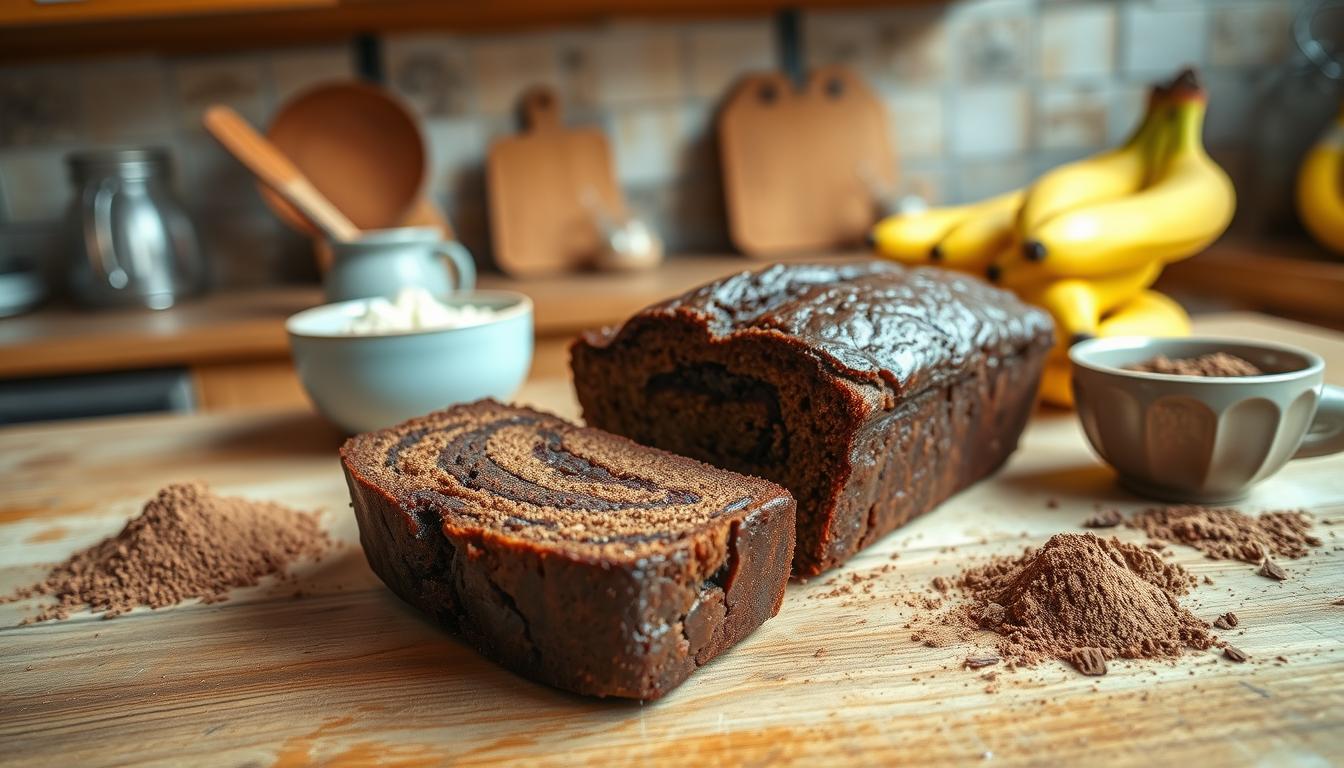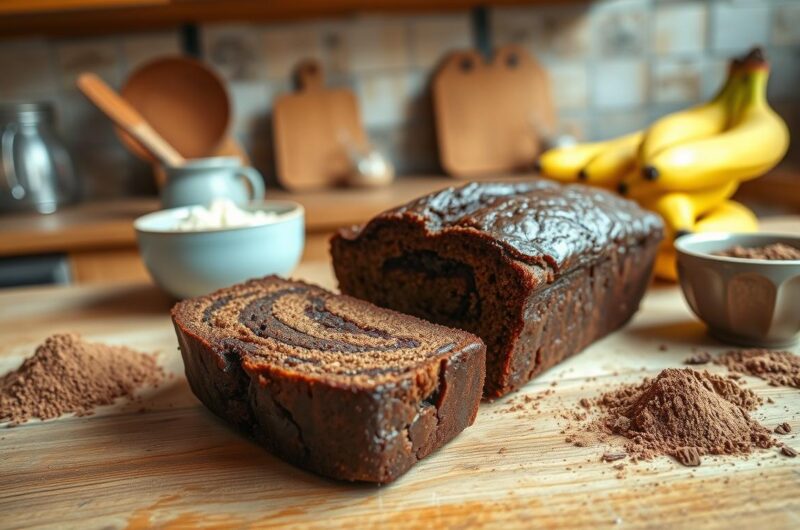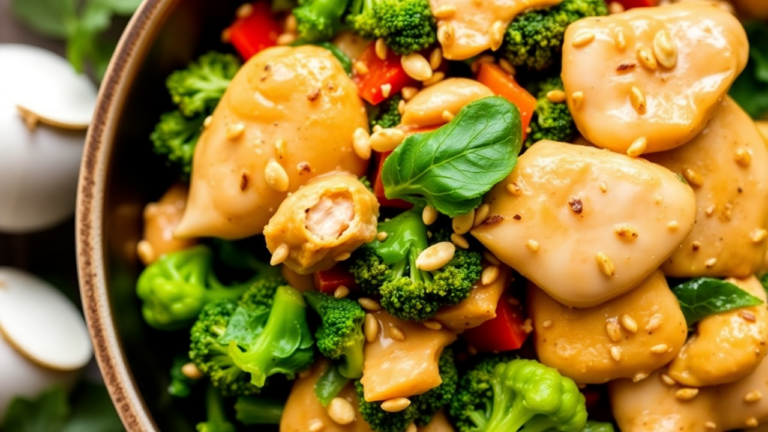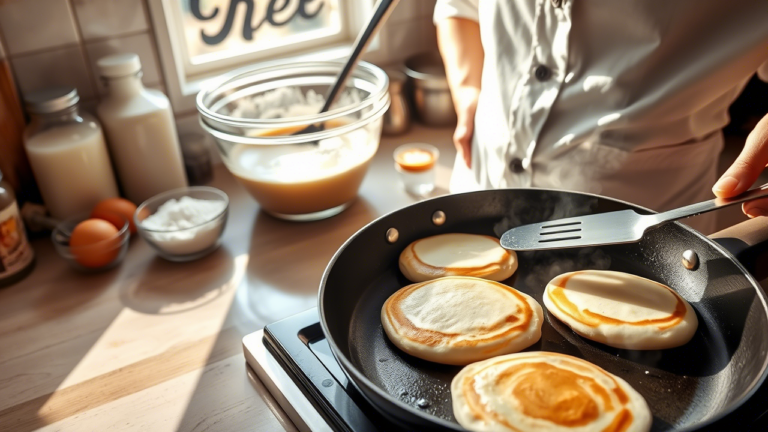How to Make Healthy Chocolate Banana Bread (Oil-free)
Craving a delicious treat that’s both satisfying and guilt-free? This oil-free chocolate banana bread is the perfect solution. Made with simple ingredients, it’s a great option for a quick snack or even breakfast. The absence of oil doesn’t compromise on flavor or texture—it’s moist, rich, and packed with natural sweetness.
How to Make Healthy Chocolate Banana Bread (Oil-free)
8-10
servings10
minutes45
minutes~150-200
kcalIngredients
3 ripe bananas (mashed)
1/3 cup unsweetened applesauce
1/4 cup maple syrup or honey
1 tsp vanilla extract
1/4 cup plant-based milk (e.g., almond, oat)
1 1/2 cups whole wheat flour (or gluten-free flour blend)
1/4 cup cocoa powder
1 tsp baking soda
1/2 tsp baking powder
1/4 tsp salt
1/2 cup dark chocolate chips (optional)
Optional add-ins: chopped nuts, chia seeds, or berries
Directions
- Prep Ingredients & Oven:
Preheat oven to 350°F (175°C).
Grease a loaf pan or line it with parchment paper.
Mash bananas in a large bowl until smooth. - Mix Wet Ingredients:
Add applesauce, maple syrup/honey, vanilla extract, and plant-based milk to the mashed bananas. Stir well. - Combine Dry Ingredients:
In a separate bowl, whisk together flour, cocoa powder, baking soda, baking powder, and salt. - Mix Batter:
Gradually add dry ingredients to the wet mixture. Fold gently until just combined (do not overmix).
Fold in chocolate chips or optional add-ins (nuts, berries, etc.). - Bake:
Pour batter into the prepared pan and smooth the top.
Bake for 45–50 minutes, or until a toothpick inserted in the center comes out clean. - Cool & Serve:
Let cool in the pan for 10 minutes, then transfer to a wire rack.
Slice and serve once fully cooled.
Notes
- Ripe Bananas: Use overripe bananas with brown spots for maximum sweetness and moisture.
Oil-Free: Applesauce and mashed bananas replace oil while keeping the bread moist.
Storage:
Room temperature: Store in an airtight container for up to 3 days.
Refrigerate: Keeps fresh for up to 1 week.
Freeze: Slice and freeze for up to 3 months (thaw before serving).
Vegan Option: Swap honey for maple syrup and use vegan chocolate chips.
Gluten-Free: Substitute whole wheat flour with a 1:1 gluten-free flour blend.
Add-Ins: Customize with nuts, seeds, or berries for texture and flavor.
Avoid Overmixing: Fold batter gently to keep the bread light and fluffy.
Testing Doneness: A toothpick inserted should come out clean or with a few crumbs.
This recipe is designed to fit seamlessly into your routine, whether you’re preparing for a busy week or hosting a casual dinner. By using ripe bananas and a few pantry staples, you can create a dessert that’s both wholesome and indulgent. Plus, it’s a fantastic way to use up overripe bananas that might otherwise go to waste.
In this article, you’ll find a detailed, step-by-step guide to making this bread, along with expert tips and variations to suit your preferences. Whether you’re a seasoned baker or just starting out, this recipe is straightforward and rewarding. Let’s get started!
Key Takeaways
- This oil-free chocolate banana bread is moist, flavorful, and guilt-free.
- It’s perfect for a quick snack, breakfast, or even a light dessert.
- The recipe uses simple, wholesome ingredients you likely already have.
- Detailed steps and expert tips ensure success for all skill levels.
- Variations allow you to customize the bread to your taste.
Introduction to Oil-Free Chocolate Banana Bread
Want to enjoy a flavorful treat without the extra calories from oil? Oil-free baking is a smart choice for those looking to reduce fat intake while still indulging in delicious baked goods. By skipping the oil, you can create a lighter version of your favorite treats without sacrificing taste or texture.
Natural ingredients like ripe bananas and applesauce play a key role in keeping this bread moist and flavorful. These ingredients not only add sweetness but also help bind the batter, making it a perfect alternative to traditional recipes. Plus, they’re packed with nutrients, adding an extra layer of goodness to your meal.
This recipe is designed to save you time. With just a few simple steps, you can have a freshly baked loaf ready in under an hour. It’s ideal for busy mornings or when you need a quick snack. The straightforward process ensures that even beginners can achieve great results.
Popular websites like Minimalist Baker and Oh She Glows emphasize the benefits of oil-free baking. They highlight how it’s a healthier option that doesn’t compromise on flavor. These platforms also stress the importance of using whole, natural ingredients to create satisfying dishes with minimal effort.
| Benefits of Oil-Free Baking | Key Ingredients |
|---|---|
| Reduces fat content | Ripe bananas |
| Enhances natural flavors | Applesauce |
| Simplifies preparation | Whole wheat flour |
Incorporating this bread into your routine is a breeze. Whether you’re looking for a quick breakfast or a light dessert, it’s a versatile option that fits seamlessly into your lifestyle. With its rich chocolate flavor and moist texture, it’s sure to become a favorite in your kitchen.
Healthy Easy Recipes: Guilt-Free Baking for Everyone
Ready to explore a new way to bake without the guilt? This oil-free chocolate banana bread is just one example of how you can enjoy delicious treats while keeping things simple and wholesome. Whether you’re a seasoned baker or just starting out, this recipe is designed to inspire confidence in the kitchen.
It’s part of a broader collection of approachable dishes that cater to various tastes and dietary preferences. From hearty Minestrone Soup to flavorful Sesame Soba Noodles, there’s something for everyone. These recipes prove that you don’t need complicated techniques or hard-to-find ingredients to create something amazing.
One of the best things about this recipe is its adaptability. Swap in ingredients like black bean puree or a sprinkle of cheese for a creative twist. These small changes can elevate the final dish while keeping it light and satisfying. It’s all about experimenting and finding what works for you.
Baking at home doesn’t have to be intimidating. With straightforward steps and minimal prep time, this recipe is perfect for busy schedules. It’s a great way to enjoy a treat that’s both indulgent and mindful of your goals. So, grab your mixing bowl and let’s get started!
Essential Ingredients for a Moist and Delicious Bread
Discover how simple ingredients can transform your baking experience. The key to making this oil-free chocolate banana bread lies in selecting the right components. Each ingredient plays a vital role in creating a moist, flavorful loaf that’s both satisfying and nutritious.
Start with ripe bananas. Their natural sweetness and moisture are essential for binding the batter and adding depth of flavor. Pair them with high-quality cocoa powder for a rich, chocolatey taste that’s hard to resist.
Other ingredients like applesauce and whole wheat flour contribute to the bread’s texture and nutritional value. Applesauce replaces oil, keeping the loaf light and moist. Whole wheat flour adds fiber and a hearty flavor, making it a better choice than refined flour.
“The quality of your ingredients directly impacts the final product. Fresh, natural components ensure a better taste and texture.”
Here’s a breakdown of the essential ingredients and their roles:
| Ingredient | Role |
|---|---|
| Ripe bananas | Adds sweetness and moisture |
| Cocoa powder | Provides rich chocolate flavor |
| Applesauce | Replaces oil for moisture |
| Whole wheat flour | Adds fiber and texture |
Even unexpected ingredients like tomato can play a role in balancing flavors in some culinary experiments. While not used here, it’s a reminder of how versatile ingredients can be. By focusing on quality and freshness, you can create a bread that’s both indulgent and mindful of your goals.
Compared to traditional recipes, this oil-free version offers a lighter alternative without compromising on taste. It’s a great example of how thoughtful ingredient choices can lead to delicious results. So, gather your ingredients and get ready to bake something truly special!
Step-by-Step Preparation Guide
Ready to bake a treat that’s both simple and satisfying? This step-by-step guide will walk you through the process of making oil-free chocolate banana bread. From prepping your ingredients to mixing the batter, every detail is covered to ensure success.
Prepping Your Ingredients and Equipment
Start by gathering all your ingredients. Peel and mash the ripe bananas until smooth. Measure out the cocoa powder, applesauce, and whole wheat flour. Ensure your baking tools are clean and ready to use.
Preheat your oven to 350°F (175°C). This step is crucial for even baking. Grease your loaf pan lightly or line it with parchment paper to prevent sticking.
- Mixing bowls (one for dry ingredients, one for wet)
- Whisk or spatula for combining
- Measuring cups and spoons
- Loaf pan (8×4 inches recommended)
Mixing and Combining the Batter
In a large bowl, combine the dry ingredients: whole wheat flour, cocoa powder, and a pinch of salt. Whisk them together to ensure even distribution.
In another bowl, mix the wet ingredients: mashed bananas, applesauce, and a splash of vanilla extract. Stir until smooth. Gradually add the wet mixture to the dry ingredients, folding gently to avoid overmixing.
“Overmixing can lead to a dense loaf. Fold the batter just until combined for the best texture.”
Pour the batter into the prepared loaf pan. Smooth the top with a spatula for an even bake. Place the pan in the preheated oven and set a timer for 45-50 minutes.
| Step | Key Tip |
|---|---|
| Preheat oven | Ensures even baking |
| Mix dry ingredients | Whisk thoroughly |
| Combine wet and dry | Fold gently |
| Bake | Check at 45 minutes |
Following these steps will help you achieve a perfectly baked loaf every time. Enjoy the process and the delicious results!
Tips for Achieving the Perfect Texture
Achieving the perfect texture in your bread is all about mastering the details. From mixing techniques to baking time, every step plays a role in creating a loaf that’s moist, tender, and just right. Here’s how to ensure your oil-free chocolate banana bread turns out flawless every time.
Mixing Techniques and Ingredient Temperature
The way you mix your batter can significantly impact the final texture. Overmixing can lead to a dense loaf, while undermixing may result in uneven baking. Gently fold the wet and dry ingredients together until just combined. This preserves the airiness of the batter.
Ingredient temperature also matters. Using room-temperature ingredients ensures even mixing and better protein activation. Cold ingredients can cause the batter to separate, affecting the bread’s consistency.
“Mixing gently and using room-temperature ingredients are simple ways to improve your bread’s texture.”
Baking Time and Consistency Checks
Baking time is crucial for achieving the right texture. Set your oven to 350°F (175°C) and bake for 45-50 minutes. Check for doneness by inserting a toothpick into the center. If it comes out clean, your bread is ready.
Another way to ensure consistency is to monitor the bread’s color and firmness. The top should be golden brown, and the loaf should spring back when lightly pressed. These small tweaks can lead to significant improvements in texture and overall quality.
| Tip | Impact |
|---|---|
| Mix gently | Preserves airiness |
| Use room-temperature ingredients | Ensures even mixing |
| Check baking time | Prevents over or under-baking |
By focusing on these techniques, you can create a bread that’s not only delicious but also has the perfect texture. Whether you’re a beginner or an experienced baker, these tips will help you elevate your baking game.
Creative Flavor Variations to Enhance Your Bread
Transform your bread with creative and wholesome add-ins. Small changes in ingredients can create a completely new taste experience. Whether you’re baking for the week or a special occasion, these variations will keep your loaf exciting and flavorful.
Add-Ins: Nuts, Berries, and Spices
Chopped nuts like walnuts or almonds add a satisfying crunch. They also bring a rich, nutty flavor that pairs well with chocolate. Mixed berries, such as blueberries or raspberries, introduce a burst of sweetness and a pop of color.
Spices like cinnamon or nutmeg can elevate the aroma and depth of your bread. For an adventurous twist, try a pinch of garlic powder. It might sound unusual, but it can add a subtle savory note that balances the sweetness.
“Experimenting with add-ins is a great way to personalize your baking and discover new favorites.”
Here’s a quick guide to how different add-ins can modify your bread:
| Add-In | Flavor Profile | Texture Impact |
|---|---|---|
| Chopped nuts | Nutty, rich | Crunchy |
| Mixed berries | Sweet, tangy | Juicy |
| Spices | Warm, aromatic | Smooth |
Encourage your creativity by trying your favorite ingredients. Whether it’s a handful of dried fruit or a sprinkle of seeds, the possibilities are endless. These small changes can make your bread a standout treat for any day of the week.
Serving Suggestions for a Quick Snack or Breakfast
Looking for a versatile treat that fits into any part of your day? This oil-free chocolate banana bread is perfect as a snack or a quick breakfast. Its rich flavor and moist texture make it a crowd-pleaser, whether you’re enjoying it at home or on the go.
Pair it with your favorite morning beverage for a balanced start to the day. A cup of coffee or tea complements the bread’s chocolatey richness. For a refreshing twist, try it with freshly squeezed orange juice.
Pairing with Morning Beverages
Here are some creative ways to serve this bread:
- With Coffee or Tea: The warmth of these beverages enhances the bread’s flavors.
- Fresh Juice: A glass of orange or apple juice adds a tangy contrast.
- Light Sides: Add a handful of fresh veggy options like cucumber slices or cherry tomatoes for a fresh touch.
For a heartier meal, pair the bread with a side of pasta salad or a small bowl of yogurt. These combinations make it a satisfying option for breakfast or a midday snack.
“Pairing your bread with complementary sides and beverages can elevate the entire experience.”
The versatility of this bread makes it ideal for busy mornings or quick snacks. Whether you’re rushing out the door or enjoying a leisurely breakfast, it’s a delicious and convenient choice.
Incorporating Superfoods for Added Nutrition
Boost your bread’s nutritional profile with simple superfood additions. Ingredients like chia seeds, flaxseeds, and antioxidant-rich options can elevate your loaf without compromising its texture. These nutrient-dense choices are perfect for enhancing your baking while keeping it wholesome.

Adding superfoods to your batter is a smart way to increase its nutritional value. Chia seeds, for example, are packed with omega-3 fatty acids and fiber. Flaxseeds provide a boost of protein and essential minerals. These additions blend seamlessly into the batter, ensuring your bread remains moist and delicious.
Superfoods are also versatile in other dishes. For instance, a grain bowl with quinoa, roasted pepper, and a sprinkle of chia seeds makes a quick and satisfying meal. These ingredients can support your energy levels, especially during busy weeknights when you need a nutritious yet convenient option.
“Incorporating superfoods into your baking is an easy way to add nutrients without altering the flavor or texture.”
Here’s a quick guide to popular superfoods and their benefits:
| Superfood | Benefits |
|---|---|
| Chia Seeds | Rich in omega-3s and fiber |
| Flaxseeds | High in protein and minerals |
| Antioxidants (e.g., cocoa) | Support overall health |
Encourage your creativity by experimenting with different nutrient boosters. Whether it’s a handful of nuts or a dash of spices, these small changes can make your bread a standout treat. By incorporating superfoods, you’re not just baking—you’re nourishing your body with every bite.
The Science Behind Oil-Free Baking
Ever wondered how oil-free baking keeps your treats moist and flavorful? The answer lies in the science of ingredient substitution and moisture retention. By understanding the chemical and physical changes that occur during baking, you can create delicious, oil-free treats without sacrificing texture or taste.
In oil-free baking, ingredients like applesauce, mashed bananas, and yogurt act as natural emulsifiers. These components bind the batter, ensuring it stays moist and cohesive. They also replace the fat typically provided by oil, maintaining the bread’s structure while reducing calories.
Moisture Retention and Ingredient Substitution
Moisture retention is crucial in oil-free baking. Ingredients like applesauce and mashed bananas contain high water content, which evaporates during baking, creating steam. This steam keeps the bread moist and tender. Additionally, these ingredients add natural sweetness, reducing the need for added sugars.
Here’s how ingredient substitution works:
- Applesauce: Replaces oil while adding moisture and a subtle sweetness.
- Mashed Bananas: Acts as a binder and provides natural sugars for flavor.
- Yogurt: Adds creaminess and helps activate baking soda for a light texture.
These substitutions not only enhance the bread’s texture but also make it more nutritious. For example, using a veggie-based puree like pumpkin can add fiber and vitamins, making the bread a healthier option.
“The right ingredient substitutions can transform your baking, making it both delicious and mindful of your goals.”
Here’s a quick comparison of traditional vs. oil-free baking ingredients:
| Traditional Ingredient | Oil-Free Substitute |
|---|---|
| Olive Oil | Applesauce |
| Butter | Mashed Bananas |
| Milk | Almond Milk |
By mastering these techniques, you can enjoy baked goods that are both satisfying and aligned with your dietary preferences. Whether you’re mixing ingredients in a bowl or experimenting with new flavors, the science behind oil-free baking makes it a rewarding culinary adventure.
Adapting the Recipe for Different Dietary Needs
Looking to tailor this recipe to fit your dietary preferences? Whether you’re vegan, gluten-free, or simply exploring new options, this bread can be easily adapted. With a few simple swaps, you can enjoy the same delicious flavor and texture while meeting your specific needs.
Vegan and Gluten-Free Options
For a vegan version, replace eggs with flax eggs or mashed bananas. These ingredients act as binders, keeping the bread moist and cohesive. Use plant-based milk like almond or oat milk instead of dairy. These swaps ensure the recipe remains animal product-free without compromising taste.
Gluten-free adaptations are just as straightforward. Substitute whole wheat flour with a gluten-free blend. Ingredients like almond flour or oat flour work well, but you may need to adjust the liquid ratios. Adding a bit more applesauce or mashed sweet potato can help maintain moisture.
“Successful adaptations, like vegan mac and cheese or gluten-free pasta dishes, show how simple swaps can create delicious results.”
Here are some tips for ingredient substitutions:
- Flax Eggs: Mix 1 tbsp ground flaxseed with 3 tbsp water for each egg.
- Gluten-Free Flour: Use a 1:1 ratio blend for best results.
- Sweet Potato: Adds moisture and natural sweetness, perfect for balancing alternative flours.
When using alternative flours, pay attention to the batter’s consistency. Gluten-free flours often absorb more liquid, so you may need to add a splash of plant-based milk or water. This ensures the bread doesn’t dry out during baking.
Despite these changes, the core structure of the recipe remains intact. The rich chocolate flavor and moist texture stay consistent, making it a versatile option for any dietary preference. Whether you’re serving it with a hearty soup or enjoying it as a quick snack, this bread is sure to satisfy.
By experimenting with these adaptations, you can create a version of this bread that works for everyone at the table. From vegan to gluten-free, the possibilities are endless. So, grab your ingredients and start customizing!
Comparisons with Traditional Banana Bread Recipes
Curious about how oil-free baking stacks up against traditional methods? Let’s dive into the differences between classic banana bread and its oil-free counterpart. While both versions are delicious, they offer unique textures, flavors, and nutritional benefits.
Traditional banana bread often relies on oil or butter for moisture. This creates a rich, dense texture that many love. However, the oil-free version uses ingredients like applesauce and mashed bananas to achieve a similar moistness. The result is a lighter loaf that’s just as satisfying.
When it comes to taste, the oil-free version shines with its natural sweetness. Ripe bananas and cocoa powder provide a rich, chocolatey flavor without the need for added fats. In contrast, traditional recipes may have a buttery undertone that some prefer.
Nutritionally, the oil-free bread is a clear winner. It’s lower in calories and fat, making it a better choice for those watching their intake. Plus, the use of whole wheat flour adds fiber, turning this treat into a more balanced option.
“Swapping oil for applesauce or bananas is a simple way to make your baking healthier without sacrificing flavor.”
Here’s a quick comparison of the two versions:
| Aspect | Traditional Banana Bread | Oil-Free Banana Bread |
|---|---|---|
| Texture | Rich and dense | Light and moist |
| Flavor | Buttery undertones | Natural sweetness |
| Nutrition | Higher in fat and calories | Lower in fat, higher in fiber |
Modern adaptations like this oil-free recipe are gaining popularity for good reason. They allow you to enjoy a treat like banana bread while aligning with your goals. Whether you’re planning a healthy dinner or just want a guilt-free snack, this version is a smart choice.
For example, adding a handful of chopped mushroom to the batter can introduce a unique twist. While not traditional, it’s a reminder of how versatile baking can be. Similarly, pairing this bread with a hearty mushroom soup makes for a satisfying meal.
In conclusion, oil-free banana bread offers a lighter, more nutritious alternative to the classic recipe. By using simple swaps like applesauce and whole wheat flour, you can create a loaf that’s both delicious and mindful of your health. It’s a great example of how modern baking can be both innovative and satisfying.
Expert Tips from Renowned Recipe Developers
What’s the secret to perfecting oil-free baked goods? Renowned chefs and recipe developers from platforms like NYT Cooking and Love & Lemons share their insights. Their tips focus on ingredient quality, precise measurements, and overcoming common baking challenges.
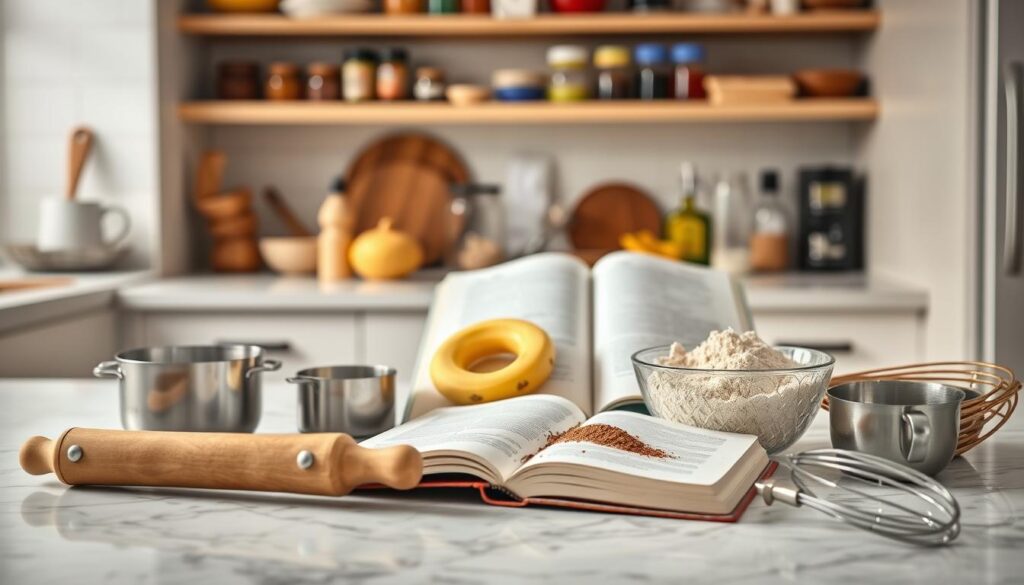
Advice from Culinary Experts
Chefs emphasize the importance of using fresh, high-quality ingredients. For example, ripe bananas and applesauce are essential for moisture and binding. Precise measurements ensure consistency, especially when substituting oil with alternatives like mashed potato or grain-based flours.
“The right balance of wet and dry ingredients is key. Overmixing can lead to a dense loaf, so fold gently until just combined.”
Reader feedback highlights the effectiveness of these techniques. Many praise the use of cocoa powder and red pepper for adding depth and complexity to the flavor profile. These small tweaks can elevate your baking results significantly.
Step-by-Step Recommendations
Here’s how to apply expert advice to your baking process:
- Measure Accurately: Use a kitchen scale for precise ingredient weights.
- Mix Gently: Fold wet and dry ingredients until just combined.
- Experiment with Add-Ins: Try nuts, seeds, or spices for unique flavors.
For example, adding roasted red pepper puree can introduce a subtle sweetness, while grain-based flours like oat or almond provide a hearty texture. These adaptations make the recipe versatile and customizable.
| Expert Tip | Benefit |
|---|---|
| Use Fresh Ingredients | Enhances flavor and texture |
| Measure Precisely | Ensures consistent results |
| Experiment with Add-Ins | Personalizes the recipe |
By following these expert tips, you can master oil-free baking and create delicious, wholesome treats every time. Whether you’re a beginner or an experienced baker, these insights will help you achieve flawless results.
Common Mistakes to Avoid When Baking
Even small errors in baking can lead to disappointing results. Whether you’re a beginner or a seasoned baker, understanding common pitfalls can save your recipe. From overmixing to mismeasuring, these mistakes can affect texture, flavor, and overall success.
One frequent error is overmixing the batter. This can develop too much gluten, resulting in a dense, tough loaf. Instead, fold ingredients gently until just combined. Another issue is mismeasuring ingredients. Baking is a science, and precise measurements are crucial. Use a kitchen scale for accuracy.
Improper ingredient preparation is another common mistake. For example, using cold eggs or butter can prevent proper emulsification. Always bring ingredients to room temperature unless specified otherwise. Similarly, forgetting to preheat the oven can lead to uneven baking.
“Small errors, like skipping a step or rushing the process, can have a big impact on your bake. Patience and precision are key.”
Here’s a quick guide to avoiding these mistakes:
| Mistake | Consequence | Prevention |
|---|---|---|
| Overmixing | Dense, tough texture | Fold gently until combined |
| Mismeasuring | Inconsistent results | Use a kitchen scale |
| Cold ingredients | Poor emulsification | Bring to room temperature |
Real-life examples show how minor errors can lead to disappointment. For instance, adding too much flour can make your bread dry and crumbly. Similarly, not greasing the pan properly can cause sticking, ruining the presentation.
To dress up your bake, consider adding toppings like nuts or a white bean spread. These additions can enhance flavor and texture. Pair your bread with a side of fresh fruit or a light salad for a balanced meal.
By being mindful and following instructions precisely, you can avoid these common pitfalls. Baking is both an art and a science, and attention to detail ensures delicious results every time.
Storing and Serving: Maximizing Freshness and Flavor
Looking to keep your baked goods fresh and flavorful for days? Proper storage is key to maintaining the texture and taste of your oil-free chocolate banana bread. Whether you’re planning to enjoy it as a quick snack or a morning treat, these tips will help you get the most out of your loaf.
Proper Storage Techniques
To keep your bread moist and delicious, store it in an airtight container at room temperature. This prevents it from drying out while preserving its rich chocolate flavor. For longer storage, wrap the loaf in plastic wrap or aluminum foil before placing it in the container.
If you live in a warm climate or want to extend its shelf life, refrigeration is a great option. Simply place the wrapped bread in the fridge for up to a week. When ready to serve, let it come to room temperature or warm it slightly for a fresh-from-the-oven feel.
“Proper storage ensures your baked goods retain their moisture and flavor, making them just as enjoyable days later.”
Serving Tips for Maximum Enjoyment
For a quick easy breakfast, pair a slice of banana bread with a cup of coffee or tea. The warmth of the beverage complements the bread’s rich flavor. You can also toast it lightly and add a spread of nut butter for extra protein.
If you’re serving it as a dessert, try pairing it with a scoop of dairy-free ice cream or fresh berries. These additions enhance the chocolatey goodness while keeping it light and satisfying.
Examples from Food Blogs
Popular food blogs like Minimalist Baker and Oh She Glows recommend similar storage methods for baked goods. They emphasize the importance of airtight containers and refrigeration for maintaining freshness. These tips are especially useful for oil-free recipes, which rely on natural moisture sources like bananas and applesauce.
By following these storage and serving tips, you can enjoy your chocolate banana bread at its best. Whether you’re savoring it with a morning coffee or as a midday snack, proper care ensures every bite is as delicious as the first.
Pairing Your Bread with Complementary Dishes
Elevate your meal with creative pairings that complement your bread perfectly. Whether you’re enjoying it as a snack or part of a larger spread, the right combinations can enhance its flavor and make it a standout dish for your family.
Accompaniments That Shine
Pair your bread with fresh fruit salads for a burst of natural sweetness. A warm bowl of soup, like a creamy tomato or vegetable broth, creates a comforting balance. For a protein boost, try light dishes such as grilled shrimp or a simple chicken salad.
Here are some ideas to inspire your next meal:
- Fresh Fruit Salad: Adds a refreshing contrast to the bread’s richness.
- Warm Soup: Perfect for a cozy, satisfying combination.
- Grilled Shrimp: A light, flavorful protein that pairs beautifully.
Beverage Pairings for Every Occasion
Enhance your dining experience with the right drink. Herbal teas, like chamomile or mint, offer a soothing complement. Freshly brewed coffee brings out the bread’s chocolatey notes. For a refreshing twist, try a glass of sparkling water with a slice of lemon.
“The right pairing can transform a simple meal into a memorable experience.”
Making It a Family Affair
This bread can serve as the centerpiece of a family meal. Pair it with a variety of sides to create a customizable spread. Let everyone mix and match their favorites, from roasted vegetables to a hearty shrimp pasta. Encourage experimentation to discover new flavor combinations.
By thoughtfully pairing your bread with complementary dishes and beverages, you can create a dining experience that’s both enjoyable and satisfying. Whether it’s a casual snack or a full family meal, these ideas will help you make the most of every bite.
Conclusion
Ready to try a baking method that’s both simple and rewarding? This oil-free chocolate banana bread is a delicious alternative to traditional recipes. By using ingredients like ripe bananas and applesauce, it stays moist without the need for oil. It’s a great way to enjoy a treat that’s lighter yet still full of flavor.
This recipe is perfect for anyone looking to explore innovative baking techniques. Whether you’re new to the kitchen or a seasoned baker, the process is straightforward and fun. Plus, the creative variations—like adding nuts or spices—let you customize it to your taste.
We’d love to hear about your experience! Share your tips or adaptations in the comments below. Let’s build a community of bakers who inspire each other with fresh ideas. Grab your mixing sheet and start baking today—your next favorite treat is just a loaf away!
FAQ
Can I make this bread without oil?
Absolutely! This recipe is designed to be oil-free, using ripe bananas and other natural ingredients to keep it moist and delicious.
What can I use instead of eggs for a vegan version?
Flaxseed meal or applesauce works great as an egg substitute. Just mix 1 tablespoon of flaxseed meal with 3 tablespoons of water for each egg.
How do I store the bread to keep it fresh?
Wrap it tightly in plastic wrap or store it in an airtight container at room temperature for up to 3 days. For longer storage, refrigerate or freeze it.
Can I add nuts or berries to the batter?
Yes! Walnuts, pecans, or fresh berries like blueberries or raspberries add a tasty twist. Just fold them into the batter before baking.
How do I know when the bread is fully baked?
Insert a toothpick into the center. If it comes out clean or with a few crumbs, it’s done. The top should also be golden brown.
Can I make this bread gluten-free?
Definitely! Swap regular flour for a gluten-free blend. Make sure it includes a binder like xanthan gum for the best texture.
What’s the best way to serve this bread?
Enjoy it warm with a cup of coffee or tea for breakfast, or as a snack with a dollop of almond butter or yogurt.
Can I use frozen bananas?
Yes, just thaw them first and drain any excess liquid. They’ll work just as well as fresh bananas.
How can I add more nutrition to this bread?
Incorporate superfoods like chia seeds, hemp hearts, or a scoop of protein powder for an extra boost.
What’s the secret to keeping the bread moist without oil?
Ripe bananas and a touch of plant-based milk or applesauce help retain moisture while keeping the recipe oil-free.
